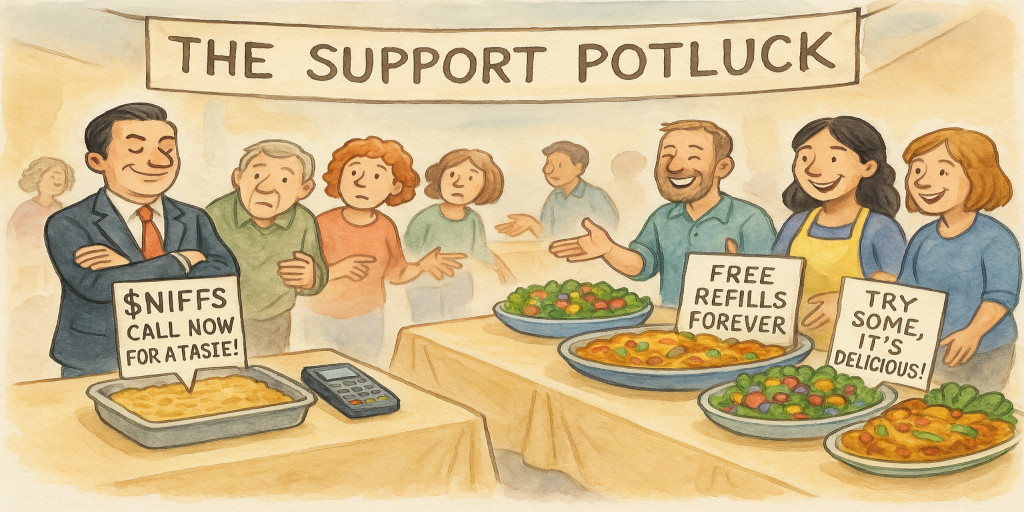Commercial Pain Points: Paywalls For Critical Support
| Published: | Friday, September 12, 2025 |
| Author: | Daniel Patterson |
Commercial Technology Vendors and the Subjugation of Customers
In an era where software and industrial systems form the backbone of business operations, many commercial technology vendors have abandoned the long-held standard of supporting their customers as a matter of principle. Historically, support after the sale was understood to be part of the product's primary value. Companies stood behind their goods, knowing that their survival depended on the loyalty of their customers.
Today, that relationship has been flipped on its head. Full support is now a gated privilege, accessible only with an active service subscription, even for products that have already been purchased at full price. This shift reflects a profit-first strategy that treats customers less like valued partners and more like captive revenue streams.
The rise of subscription-based software magnifies this problem. On the surface, paying a modest monthly fee may appear to democratize access to tools that once demanded heavy upfront investment. But beneath the surface lies the stark reality that if a payment is missed, or if budget constraints force an organization to cancel their service, the software evaporates. One day after the due date, the customer is locked out of their own workflows, projects, and even intellectual property. Business-class software that once lived on an internal server or dedicated PC and could be counted on to function indefinitely with no payments at all is now subject to the whims of subscription renewals.
Even when paying monthly, customers are rarely finished outlaying cash. A separate service contract is often required for access to the very support needed to make the software operate as promised in the glossy brochures and sales pitches. Without it, organizations are left to fend for themselves, unable to fully utilize the tools they are already financing.
The issue becomes even more treacherous in the industrial control and robotics sector, where physical hardware is involved. Unlike software, machinery cannot simply be deleted from existence. Yet manufacturers have concocted equally coercive tactics. Periodic license validations are embedded in the devices' operating systems, ensuring that critical subsystems shut down if payments are not made on time. A perfectly functional machine is deliberately hobbled and held hostage until the proper fee is paid.
This practice, crippling a tangible, manufactured device unless the customer continuously pays, skirts the edge of what should legally be classified as extortion. But because it is codified in expansive service contracts, companies in manufacturing are forced to comply. Their only alternative is to come to a grinding halt in production, which in turn, jeopardizes their ability to compete in their own entirely unrelated markets.
In short, commercial vendors have perfected the art of extracting payment not just for innovation, but for access to functionality and reliability that customers should already rightfully own.
The Open-Source Alternative of Ownership and Community
Open-source technology offers a strikingly different model. This is one built not on coercion, but on collaboration. While professional service and maintenance contracts certainly exist in the open-source ecosystem, they operate on a fundamentally different foundation. Support isn't ever contingent upon endless payments to a corporate overlord. Instead, it arises naturally from an engaged community that values the shared success of both the product and its users.
When issues arise, they are often resolved through direct interaction with developers and fellow users who are motivated not by profit margins, but by the satisfaction of solving a problem and improving the tool for everyone. This creates an environment of authentic care and mutual respect, where technical support is a conversation rather than a transaction.
Most importantly, open-source products do not evaporate. Whether or not a user has ever paid for support, the software remains theirs permanently. It doesn't shut down, lock up, or demand ransom for continued functionality. Updates, when released, are provided freely, allowing all users to benefit from ongoing improvements indefinitely. The concept of community ownership is real and enduring.
This model demonstrates the broader societal benefit that open-source communities embody a culture of empowerment and trust, standing in sharp contrast to the modern commercial norm of customer subjugation. Users aren't trapped in endless cycles of payment, but participants in a collective effort where innovation, transparency, and freedom drive continuous progress.
In more than one sense, open source restores dignity to the relationship between technology and its users. It reminds us that all tools only exist to serve their operators, not to enslave them.
 werMake
werMake